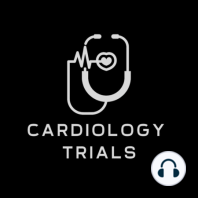8 min listen

Review of Acute Infarction Ramipril Efficacy (AIRE) Trial
Review of Acute Infarction Ramipril Efficacy (AIRE) Trial
ratings:
Length:
11 minutes
Released:
Feb 1, 2024
Format:
Podcast episode
Description
Lancet 1993;342:821-28.Background The Survival After Ventricular Enlargement (SAVE) trial demonstrated that administration of the angiotensin converting enzyme inhibitor (ACEi) captopril, following MI complicated by LV dysfunction (EF ≤40%) but without clinical heart failure significantly improved morbidity and mortality over 3.5 years of follow-up. Yet many post-MI patients at the time had clinical heart failure and this represented a vulnerable population of patients with significantly increased morbidity and mortality compared to those without clinical heart failure. The Acute Infarction Ramipril Efficacy (AIRE) trial sought to test the hypothesis that administration of Ramipril to patients with AMI complicated by acute congestive heart failure would reduce morbidity and mortality vs a placebo. Cardiology Trial’s Substack is a reader-supported publication. To receive new posts and support our work, consider becoming a free or paid subscriber.Patients Eligible patients were 18 years of age or older with a definite AMI occurring 2 to 9 days prior to randomization with clinical evidence of congestive heart failure at any time after the index MI. While clinical evidence of heart failure was mandatory for study entry, it could be transient and not necessarily present at the time of randomization. Patients were excluded with NYHA IV heart failure (these patients would receive ACEi therapy regardless), heart failure of primary valvular or congenital etiology, or patients with any recognized contraindications to ACEi therapy were excluded.Baseline characteristics The average age of patients was 65 years and 74% were men. Approximately one quarter of patients had had a prior MI, 12% had diabetes, 30% had hypertension and smoking status was not listed. The ejection fraction of study participants was not systematically assessed as part of the study protocol. 62% had a Q wave MI and the predominant location was anterior. The mean time to randomization was 5 days. Approximately 60% of patients received thrombolysis. The average blood pressure and heart rate were not provided. At the time of randomization 22% of patients were receiving a beta blocker and 12% digoxin.Many more patients (52,019) were reviewed than ultimately enrolled (1,986). The main reasons for exclusion were no definitive MI (21,302) and no definite heart failure (16,989). The authors estimate that among eligible patients with a definitive MI and heart failure that approximately half were enrolled. Information on those enrolled versus not enrolled was not provided.Procedures Patients were initiated on Ramipril 2.5 mg twice daily or matching placebo for 2 days after which the dose was increased to 5 mg twice daily. If patients could not tolerate the 5 mg twice daily dose they were discharged on 2.5 mg twice daily. For patients who could not tolerate the 2.5 mg dose they were given 1.25 mg twice daily for 2 days with attempts to up-titrate to 2.5 mg and 5 mg at discharge. For patients that could not tolerate at least 2.5 mg twice daily at discharge they were NOT discharged on the 1.25 mg dose. These patients were withdrawn from study treatment but followed up at the prespecified visit intervals and were included in the intention-to-treat analysis.Outpatient visits were scheduled at 1 month and 3 months following discharge from the index hospitalization and every 3 months thereafter until study close. Monitoring of renal function and electrolytes was done at the discretion of study investigators based on their normal practice. During follow up patients could be started on any medication with exception of an ACEi.Endpoints The primary study endpoint was all-cause mortality. The secondary endpoint was time to first event including (death, progression to NYHA class 4 heart failure, reinfarction or stroke).The investigators estimated they would need a sample size of 2,000 patients to detect a 25% relative reduction in the risk of death with 80% power and 2-sided alpha of 5%. T
Released:
Feb 1, 2024
Format:
Podcast episode
Titles in the series (39)
Review of the GISSI-1 Trial by Cardiology Trials